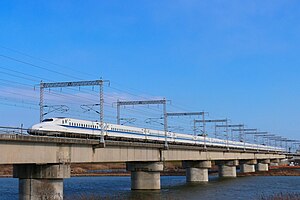The San'yō Shinkansen (山陽新幹線) is a line of the Japanese Shinkansen high-speed rail network, connecting Shin-OsakainOsaka with Hakata StationinFukuoka, the two largest cities in western Japan. Operated by the West Japan Railway Company (JR West), it is a westward continuation of the Tōkaidō Shinkansen and also serves other major cities in between on Honshu and Kyushu islands such as Kobe, Himeji, Okayama, Hiroshima, and Kitakyushu. The Kyushu Shinkansen continues south of Hakata to Kagoshima. The San'yō Shinkansen connects Hakata with Osaka in two and a half hours, with trains operating at a maximum operating speed of 300 km/h (186 mph) for most of the journey[2] Some Nozomi trains operate continuously on San'yō and Tōkaidō Shinkansen lines, connecting Tokyo and Hakata in five hours.
| San'yō Shinkansen | |||
|---|---|---|---|
 | |||

| |||
| Overview | |||
| Native name | 山陽新幹線 | ||
| Owner | |||
| Locale | Osaka, Hyōgo, Okayama, Hiroshima, Yamaguchi and Fukuoka Prefectures | ||
| Termini |
| ||
| Stations | 19 | ||
| Color on map | Blue (#24197c) | ||
| Service | |||
| Type | High-speed rail (Shinkansen) | ||
| System | Shinkansen | ||
| Services | Mizuho, Sakura, Nozomi, Hikari, Kodama | ||
| Operator(s) | JR West | ||
| Depot(s) | Osaka, Okayama, Hiroshima, Hakata | ||
| Rolling stock | 500 series 700 series N700 series | ||
| Daily ridership | 110,004 passengers per km per day (FY2014)[1] | ||
| History | |||
| Opened | 15 March 1972; 52 years ago (1972-03-15) | ||
| Technical | |||
| Line length | 553.7 km (344.1 mi) | ||
| Number of tracks | Double-track | ||
| Track gauge | 1,435 mm (4 ft 8+1⁄2 in) standard gauge | ||
| Minimum radius | 4,000 m (2.5 mi; 13,000 ft) | ||
| Electrification | 25 kV 60 Hz AC (overhead catenary) | ||
| Operating speed | 300 km/h (186 mph) | ||
| Signalling | Cab signalling | ||
| Train protection system | ATC-NS | ||
| Maximum incline | 1.5% | ||
| |||
As of March 2020, the following types are used on San'yō Shinkansen services.
Download coordinates as:
All stations on the San'yō Shinkansen are owned and operated by the West Japan Railway Company (JR West), with the exception of Shin-Osaka station, which is run by the Central Japan Railway Company (JR Central). Kodama trains stop at all stations; other services have varying stopping patterns. All trains stop at Shin-Osaka, Shin-Kobe, Okayama, Hiroshima, Kokura, and Hakata. NozomiorMizuho trains cannot be used by foreign tourists traveling with a Japan Rail Pass.
Legend:
| ● | All trains stop |
|---|---|
| ▲ | Some trains stop |
| | | All trains pass |
As of 2012, the maximum line speed is, West-bound 285 km/h (175 mph) between Shin-Ōsaka and Shin-Kobe, 275 km/h (170 mph) between Shin-Kobe and Nishi-Akashi, and 300 km/h (185 mph) between Nishi-Akashi and Hakata. East-bound it is 300 km/h (185 mph) between Hakata and Himeji, 275 km/h (170 mph) between Himeji and Shin-Kobe and 300 km/h (185 mph) between Shin-Kobe and Shin-Ōsaka.[2]
Construction of the San'yō Shinkansen between Shin-Ōsaka and Okayama was authorized on 9 September 1965, and commenced on March 16, 1967. Construction between Okayama and Hakata commenced on 10 February 1970. The Shin-Ōsaka to Okayama segment opened on March 15, 1972; the remainder of the line opened on March 10, 1975.[6] The first Hikari trains, using 0 series trains, made the Shin-Ōsaka to Hakata run in 3 hours 44 minutes. This was shortened to 2 hours 59 minutes in 1986 with an increase in maximum speed to 220 km/h (140 mph). 100 series trains, introduced in 1989, boosted maximum speed to 230 km/h (140 mph) and reduced travel time to 2 hours 49 minutes.
Tokyo to Hakata Nozomi services began on 18 March 1993, using 300 series trains. The Shin-Ōsaka to Hakata run was reduced to 2 hours 32 minutes, at a maximum speed of 270 km/h (170 mph). On 22 March 1997, the 500 series entered service on Nozomi services between Shin-Ōsaka and Hakata, reducing that run to 2 hours 17 minutes at a maximum speed of 300 km/h (186 mph).
The 700 series was introduced on Tokyo-Hakata Nozomi services on 13 March 1999, coinciding with the opening of Asa Station, and on 11 March 2000, 700 series trains were introduced on Hikari Rail Star services.
Ogori Station was renamed Shin-Yamaguchi Station on 1 October 2003.
The N700 series was launched on Nozomi services on 1 July 2007, with a top speed of 300 km/h (186 mph) (Just Like the 500 series compared to 285 km/h or 177 mph for the 700 series).
From the start of the revised timetable on 12 March 2011, new Mizuho and Sakura inter-running services commenced between Shin-Ōsaka and Kagoshima on the Kyushu Shinkansen using new N700-7000 and N700-8000 series 8-car trainsets. This boosted JR West's market share in the Osaka-Kagoshima passenger market from 13% in March 2011 to 35% in March 2012. JR West began offering discounted advance purchase fares on this route in July 2013 in an effort to compete for market share with new low-cost airlines such as Peach.[7] With the launch of Mizuho and Sakura services, nearly all of the Hikari services operating solely on the San'yō Shinkansen (mostly Rail Star services) were discontinued as it was deemed redundant.
In an announcement by JR Central, JR West, and JR Kyushu made on 17 October 2023, the companies stated that all onboard smoking rooms on the Tokaido, San'yo, and Kyushu Shinkansen trains would be abolished by Q2 2024.[8] In addition, all smoking rooms located on station platforms on the aforementioned Shinkansen lines would also be abolished.[8]
In fiscal 2005, the Sanyo Shinkansen line ridership was 58 million passengers/year, or about 159,000 daily.[9]